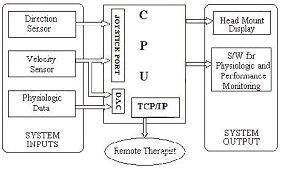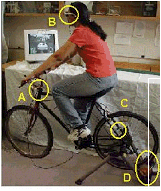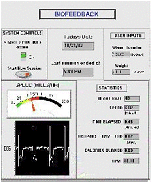REMOTE REHAB-AT-HOME (rRAH): VIRTUAL REALITY SYSTEM FOR PROMOTING HOME CARDIAC REHABILITATION
ABSTRACT
Physical inactivity is the major cause of cardiovascular diseases (CVD). Poor patient motivation and commuting have decreased patient's participation and compliance to the cardiac rehabilitation (CR) program. Innovative at-home CR programs will increase the adherence rates. The rRAH system is a motivative, interactive and engaging home-based virtual reality bike system with biofeedback and remote supervision and control. It interfaces a conventional bicycle to the virtual environment and provides biofeedback and remote consultation. This system is an effective home-based CR unit maintaining the quality of care one gets in traditional rehabilitation programs.
BACKGROUND
According to the American Heart Association (AHA), cardiovascular disease (CVD) is the number one cause of death in the United States, claiming 40.1% of deaths in 1999 [1] Statistics show one in five persons have some form of CVD. Between 11-38% of the total cardiac patients receive cardiac rehabilitation services, 30-40% of whom drop out within six months [2, 3]. Frequency, intensity and duration of regular, moderate aerobic exercise are key factors in modifying and improving risk of cardiac events. In addition to high dropout rates in CR programs, compliance with such programs are also obstacles to successful rehabilitation.
Factors affecting compliance include lack of motivation (52.8%), inadequate information (38.1%), and socioeconomic issues (9.5%) [4]. Other factors include distance to rehabilitation centers, transportation, family support, and physical inactiveness [5]. Designing customized at-home CR programs to individuals may provide a solution to improving compliance.
PROBLEM STATEMENT
Physical inactiveness is the major cause of CVDs, obesity, and other chronic illnesses that result in disability. The hypothesis of this project is that the adherence to cardiac rehabilitation regimens can be enhanced (i.e. frequency, duration, intensity and compliance) using integrated virtual reality interfaces combined with biofeedback to at-home users. The specific aims of the project are to develop a system for remote Rehab-at-Home, rRAH) for promoting aerobic exercise in patients with cardiovascular disease, disability, and/or other illnesses. The system is designed to be engaging, motivating, interactive and may be medically supervised by remote clinicians.
DESIGN
 |
| |
|
| Figure 2: The rRAH system shown (left) with 200kΩ steering potetiometer (A), head-mounted display (B), velocity sensor (C), and tension controller (D). The LabView software display (right) is used for biofeedback and remote monitoring. d |
|
DEVELOPMENT
The key components of the system hardware are a Pentium-based PC with 128 MB RAM running the video game environment and monitoring software, platform for converting any conventional bicycle into a stationary system, sensors (magnetic for velocity, 200 kΩ linear potentiometer for direction sensing), tension-controller for dynamic control of workload, signal conditioning hardware for converting analog velocity information to TTL-compatible joystick inputs, data acquisition hardware/software, head-mounted display for increased immersion, and a PC joystick port. The integration of the entire hardware and software design for the rRAH system is shown in Figure 2.
EVALUATION
Performance data calculated by the LabView software are validated using gold standards. A stopwatch is used to verify exercise duration and a BackTrailsTM cyclo-computer (PTI Sports; Taiwan) is used to validate distance covered, speed, and RPM measures.
DISCUSSION
System setup takes approximately 4 minutes which includes mounting the bicycle, calibration, and sensor placement. The expected cost for the rRAH system is $1500, which includes the cost of the computer, head-mounted display, videogames, platform assembly and sensors. Further refinement of the system may allow for a price target of $500, reaching consumer affordability. Several systems exist using the VR cycling concept, which are similar to the proposed rRAH system. However, these systems do not incorporate the various biofeedback measures proposed herein (i.e. physiologic, performance, external interactivity), but cost upwards of $10,000. Additionally, real-time physiologic data, performance data, patient report cards serve as significant biofeedback tools in motivating the patients.
The added interactivity of remote clinical consultation may serve as further motivation for users and may ensure patient safety during at-home exercise. Further, the convenience of at-home CR may also have the added benefit of flexibility in exercise scheduling and eliminate obstacles due to transportation issues. Subjective reevaluation and performance-based target setting by the therapist can be performed remotely. Lastly, the user-selectable and interchangeability of the virtual environments create an enjoyable, dynamically changing environment that is customizable to patient preferences. Thus, through the innovative use of computer, information, and sensor technologies, the rRAH system promotes exercise rehabilitation and may potentially increase CR compliance, i.e. frequency, duration and the adherence to the CR program.
REFERENCES
-
2002 Heart and stroke statistical update, American Heart Association.
-
US Census. US Department of Commerce, 1997.
-
Clinical Practice Guideline: Cardiac Rehabilitation. Agency for Health Care Policy and Research, 1995.
-
J, D., et al., Barriers to participation in and adherence to cardiac rehabilitation programs: a critical literature review. Prog Cardiovasc Nurs, 2002. 17(1): p. 8-17.
-
P, G., et al., Compliance with cardiac rehabilitation in the elderly. Eur Heart J, 1984. 5(E): p. 109-11.
ACKNOWLEDGMENTS
This design project was funded by the American Heart Association Mid-Atlantic Affiliate, RERC on Telerehabilitation (NIDRR, Dept of Education) and The Whitaker foundation.
Mailing Address:
Ms. Sheetal Pinjarkar
Dept of Biomedical Eng (Pangborn Hall)
The Catholic University of America
620 Michigan Avenue, NE
Washington, DC-20064
EMAIL: 66pinjarkar@cua.edu


